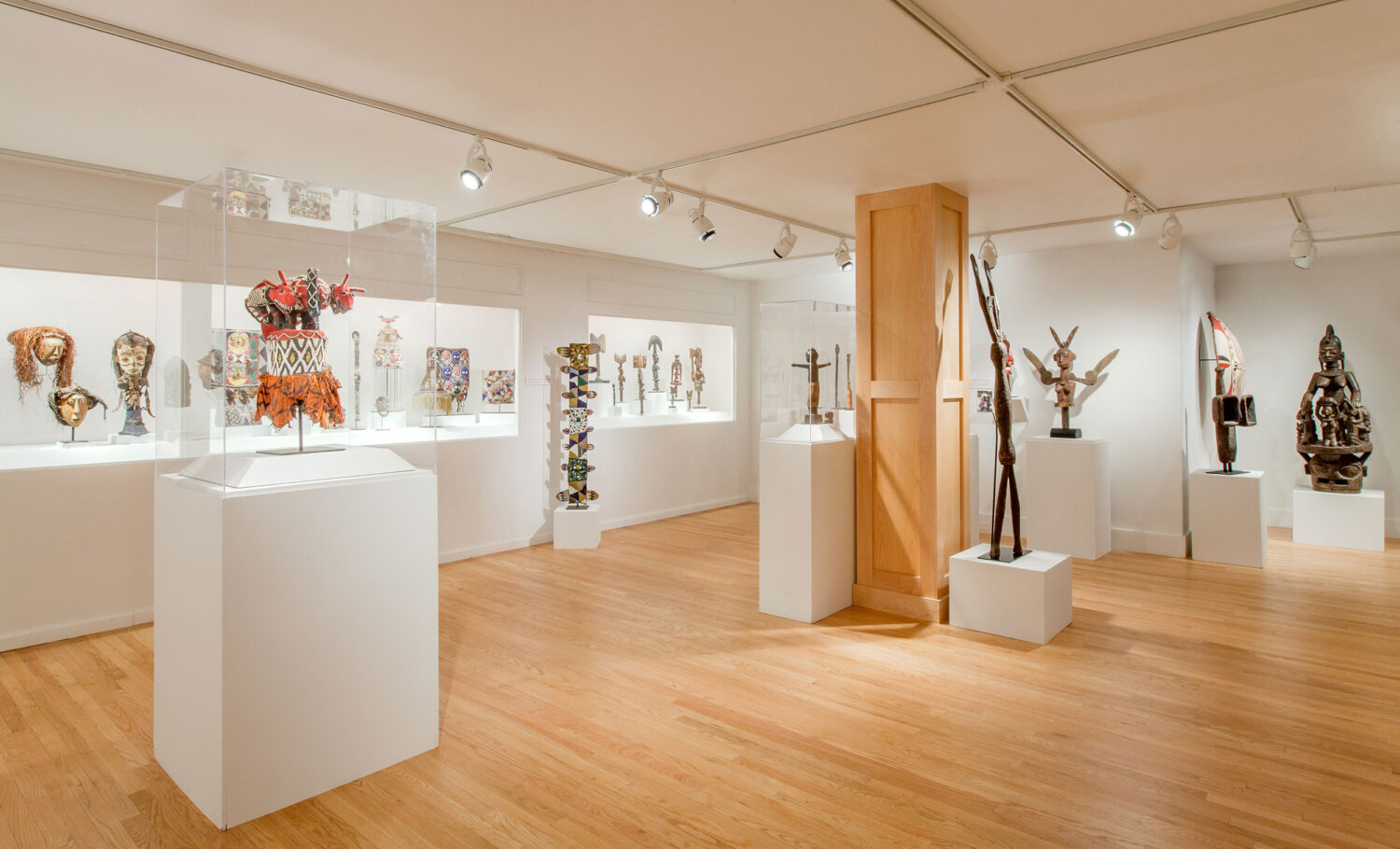
-
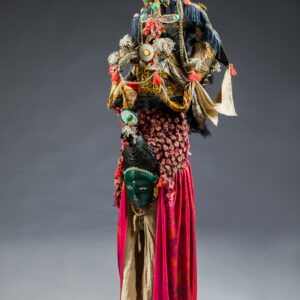
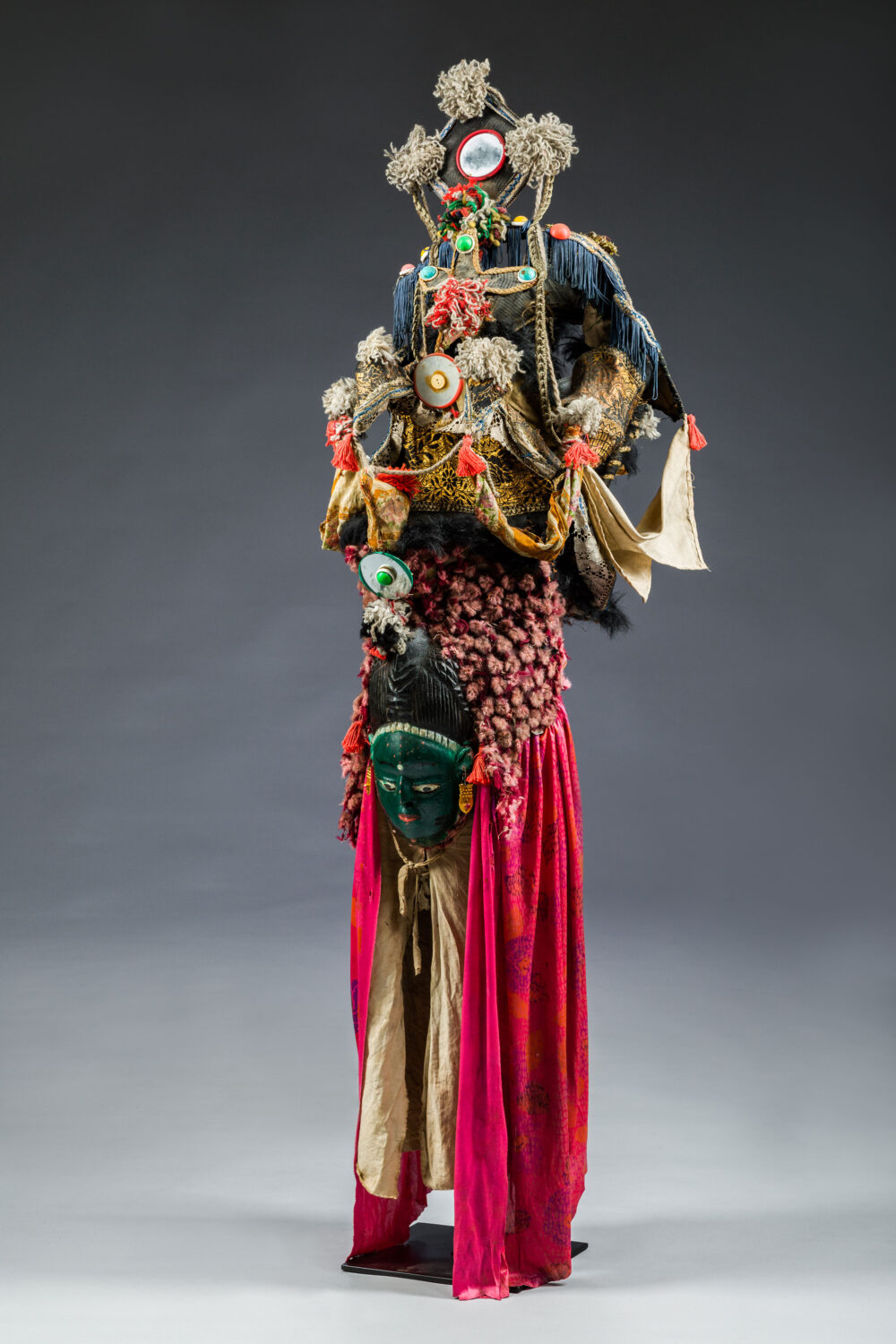
Jolly Masquerade Headpiece
Temne, Sierra Leone
Wood, fabric, mirrors. nd
Acc. No. 15-42-01
Gift of James WilsonIn post-slavery 1800’s, a variety of peoples—Yoruba, Igbo, and Kru— settled in Freetown, Sierra Leone, mixing with Mende and Temne inhabitants, and bringing with them masquerades including Egungun and Gelede. Men’s dance groups, now called Jolly masqueraders, celebrated an amalgam of characters and phenomena. This headpiece is a tribute to Al-Buraq, the winged horse with a woman’s head, once ridden by the Prophet Mohammed (John Nunley in Mami Wata: 74). The mask would have been worn at a slant atop the dancer’s head; he saw through a crochet veil just below the face. In motion, mirrors flash light, and the white scarves fly about.
-


Standing Male Figure
Wadumbo (?), Democratic Republic of the Congo
Wood. late 19th century
Ht: 16 1/4 inches
Acc. No. 03-18-01
Gift of Helena Segy -

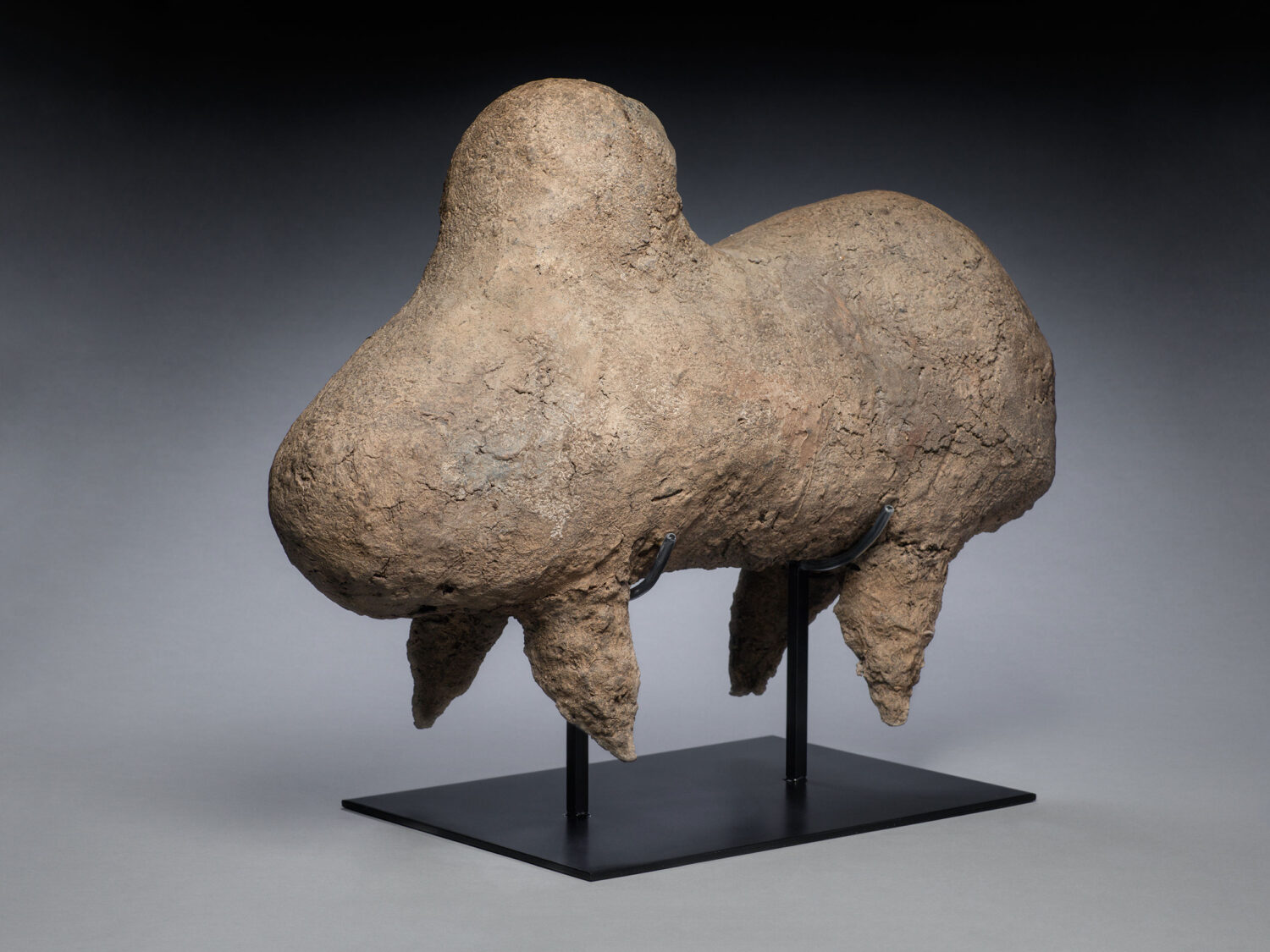
BOLI POWER FIGURE
Minianka, Cercle of Segou, Mali.Wood, encrusted materials. 28 x 19 incheslate nineteenth or early twentieth century.Accession Number: 19-06-22Gift of Eugene V. NetzerBoliw (singular boli) are magical power objects that the Bamana and Minianka use to assess accusations, divine guilt, and punish wrongdoers, especially sorcerers. They are created in a variety of forms including round balls, sticks and branches, human-like figures, and cows. The encrusted surfaces on them consist of a heterogeneous mixture of elements that include millet porridge, alcoholic liquids, chewed kola nuts, saliva, the blood of sacrificial animals such as chickens, goats, sheep, dogs, monkeys, and cattle, and animal and human excrement. All of these encrusted surfaces are viewed as possessing enormous amounts of nyama, a vital life force or energy. Thus, they are extremely powerful. As power objects, boliw are used as agents of social control, to promote the general social welfare, and to judge and punish sorcerers. It was also believed that they could be used to destroy one’s enemies.This boli, in the form of a Zebu cow with a hump on its back, was created by the Minianka people, southeastern neighbors of the Bamana of Mali. It was the boli of a village chapter of the Kono initiation society. The purposes of this society are to promote female and agricultural fertility, and to promote human morality and knowledge.– Pascal James Imperato -


Commemorative Royal Headpiece (Shrine)
Western Grassfields: Balikumbat, Cameroon
Brass, copper. nd.
ht: 18 ½ inches
Acc. No. 17.07.02
Gift of Amadou NjoyaUsing the lost-wax casting method, this old and delicately detailed mask is a masterful example of the ironwork produced in Cameroon. A common characteristic is portrayed here by the large puffy cheeks representing wisdom, and the chameleon crown which symbolizes the virtuous trait of awareness.
The chameleons are emerging out of the royal crown which has the form of a ritual ceramic “country” pot. The pot contains all ritual and sacrificial materials connected with the living and the deceased ancestors.
This headpiece was used mostly in a shine, but taken out and worn during special ceremonies.
-

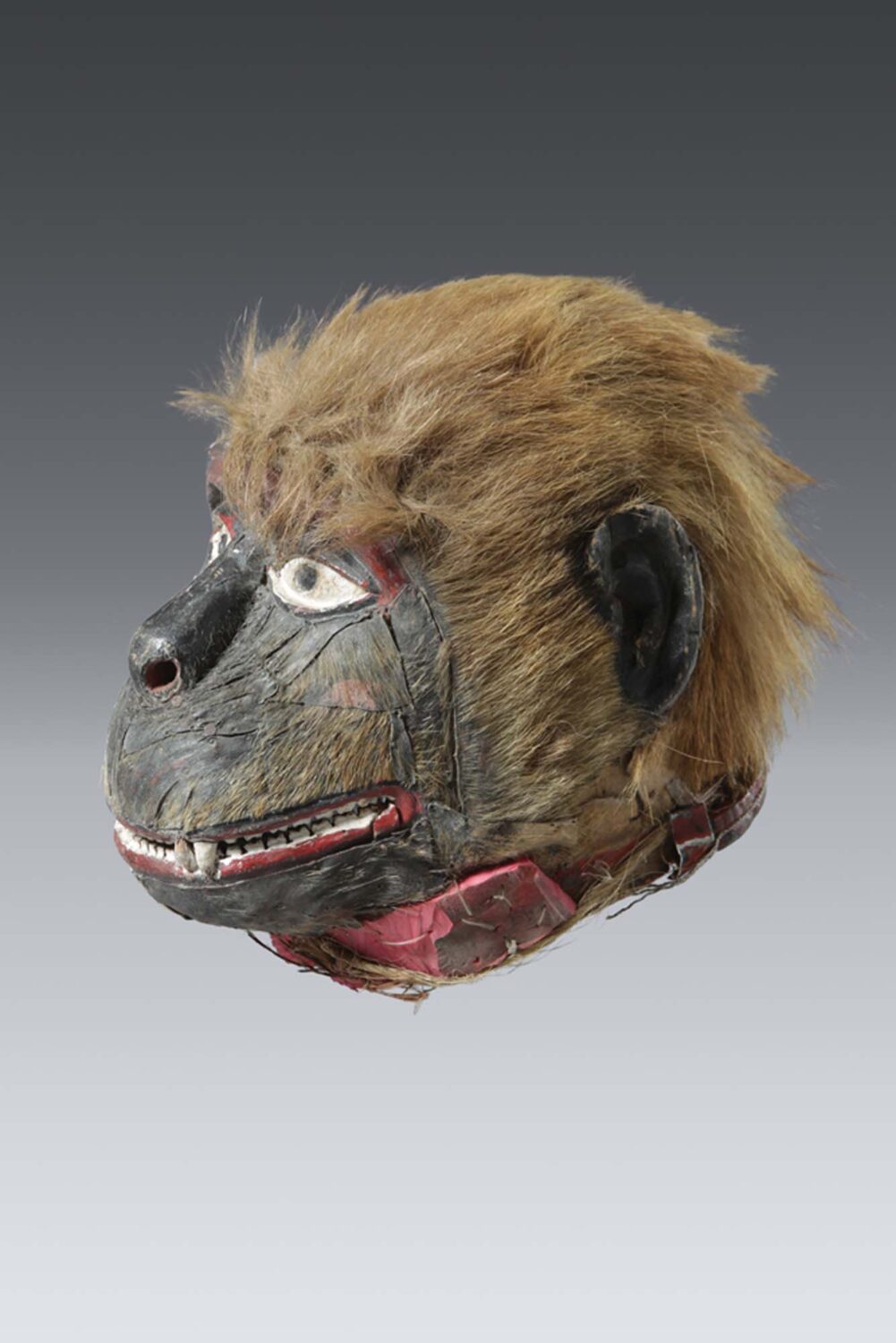
Helmet Mask
Makonde, Tanzania
Wood, fur, textile, pigments. 20th century
ht: 13 1/2 inches
Acc. No. 13-02-06
Gift of Stewart WarkowMang’anyamu, like the performances of Shumu, Lipato, and Kulombanungu (Jackson shares a clan affiliation with Kulombanungu), is conceived as a series of masked performances, in which multiple masked individuals dance together and in succession. Performances generally include masks depicting a crocodile, a leopard, a monkey, and a rhinoceros. The dancer impersonate the animal whose.
-
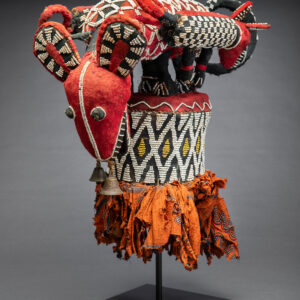

Leopard Headcrest
Cameroon, Bamun (Bamileke)
Textile, beads, brass bells. nd
ht:
Acc. No. 13-03-59
Gift of Stewart J. Warkow -
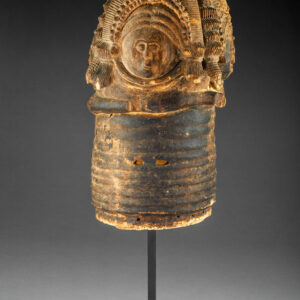
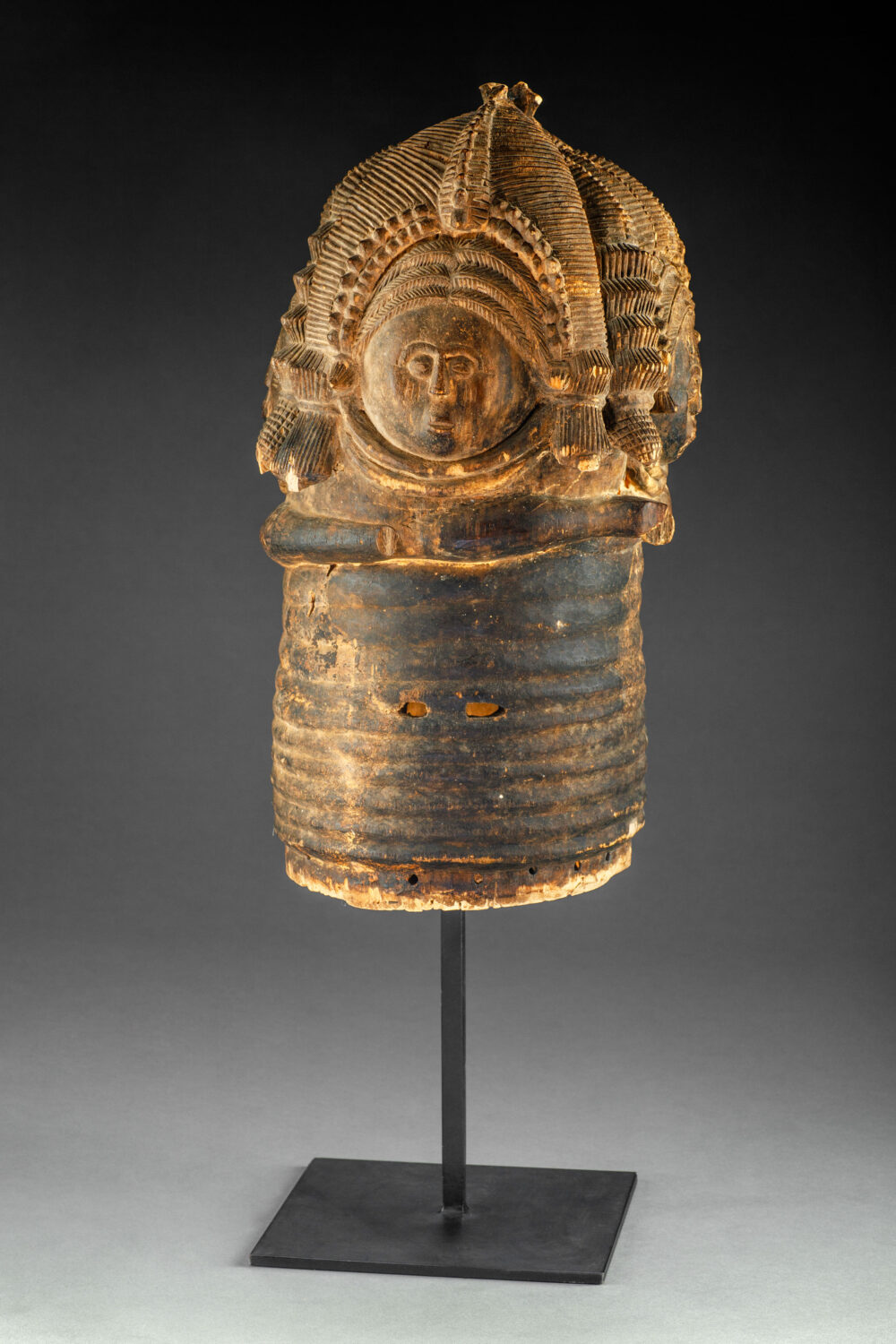
-


Mask
Fang, Gabon
Wood, pigment. nd
ht: 19 1/2 inchesAcc. No. 15.39.01
Gift of William McGuireFang wood face mask, kaolin coated of slender form, rectangular mouth with carved teeth, long nose continuing into an arching brow that curves into a vertical band on each side of the face, small and closely set narrow pierced eyes, peaked crown ridge, curving flange ears, multiple perimeter holes for attachment and with two fiber tufts, zigzag and linear scarifications on the right cheek, kaolin and black pigment and a very good patina.
-


Royal Throne
Cameroon, Bamileke Kingdom
Wood, glass beads, textile. ca. 1910
Acc. No. 05-24-01
Gift of H.E. Alexis M. Fayou de HappiThe throne has been previously owned by one of the princes of the Southern Bamileke Kingdom of Bana.
Among the populations of the Cameroon Grassfields, whose socio-political organization has traditionally been characterized by kingdoms of varying sizes, a king’s or Fon’s throne (or commemorative stool) is the highest ranking art object  in a rich artistic universe including many other objects of pride. These impressive and conspicuous sculptures with one upright figure or a pair of them are the highest symbol of the office of kingship and an expression of the sovereignty and wealth of the kingdom.
They are displayed publicly on major ceremonial occasions such as royal funerals and kingdom-wide harvest celebrations when they stir and dazzle the attending crowds. A throne may represent/stand-in for an absent Fon and it requires the most assiduous care while being stored, which is during most of the year, when only the Fon has access to it.
With a few exceptions (notably Bamum), thrones with figures attached to them were not meant to be sat upon, but rather to be commemorative monuments recording a given Fon’s reign. In the course of royal succession, actual physical contact with the throne on the part of the heir-apparent legitimizes the dynastic succession and provides continuity from father to son, while each ascendant to the throne must ultimately have his own carved to commemorate his reign. This could only take place after the new king’s wife had given birth to a child conceived on the leopard pelt thus proving the new king’s virility which is seen as tantamount to the vitality of the kingdom as well as assurance of its continuity.
Typical of this prestige art is the visual discourse integrating the three-dimensional, pole-like figures with the two-dimensional motifs of the bead design which is here rendered in the Bamileke style of generously long zigzag lines drawn horizontally over the entire sculpture. But not only does the beaded surface provide a definition of the figures’ features (eyes, nose, mouth, headdress), this design moreover carries an important iconic symbolism. It has evolved from the geometric sign of the triangle — distinctly applied in the male figure’s headdress — which represents the natural pelt marks of the leopard, the alter ego of the Fon and the very animal appropriately supporting the royal figures on this stool. The  leopard itself is depicted in typically alert and crouching stance with his prominent ears signaling the vigilance that equally must characterize a Fon. Both platforms of the stool show a diamond motif, a configuration of two triangles, here representing fertility by visual analogy to a vagina schematization. The European glass beads themselves are a sign of wealth and royal prerogative having been traded as luxury goods since pre-colonial times.
The male and female figures are positioned to have their bodies turned toward each other while their heads are shifted frontally in alignment with the caryatid of the leopard. The right male figure carrying a gun is likely a representation of the Fon. Beyond being the generic sign of power that it is universally, the gun here has acquired a different and more benevolent symbolism: when used by the Fon, the gun’s  forceful emissions take on the equivalence of the Fon’s breath, which for its potency is seen as fertilizing his country. What we see here then is a visually complex system of symbolic references which reinforce each other in the representation of royal might and authority.
Tamara Northern
Senior Curator Emerita
Hood Museum of Art, Dartmouth College -

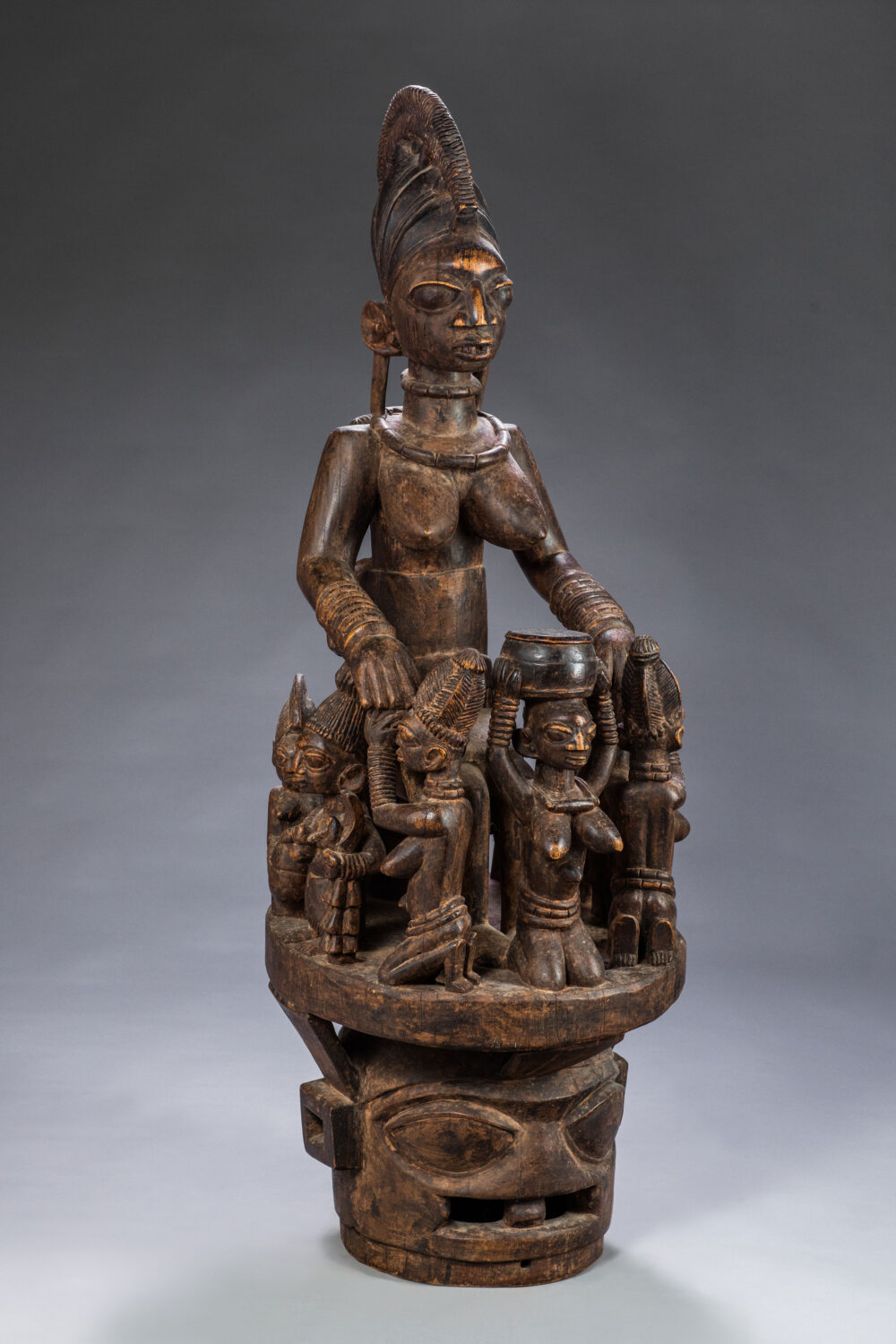
Helmet Mask
Yoruba, Nigeria
Wood. pigment. nd.
ht: 5 feet 7 inches
Acc. No. 12.42.15
Gift of Stewart Warkow -
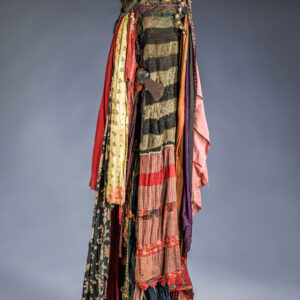

Egungun Costume with Headcrest
Yoruba, Nigeria
Wood, textile, pigment. nd.
ht: 83 inches
Acc. No. 14.11.10
Gift of Leonard and Judith KahanEgungun performances honor ancestors with drumming, dance, and elaborate costumes that reflect well upon a lineage and its deceased ancestors. An extended family will band together to afford such a display, since each element must be separately purchased. A headpiece is commissioned, colorful fabrics are purchased from various sources, a netting veil made, cowries and accoutrements bought, and the whole thing assembled to accommodate a dancer’s body. Three-headed Egungun carry complex meanings. The larger head at the center is flanked by two smaller heads, perhaps recognizing the departed’s identity as iya ibeji (mother of twins). The axe may refer to Sango, protector of twins, and the small, attached bow string with cowries relates to Osoosi, deity of the hunt. Egungun and Ibeji are related conceptually, as both acknowledge origins in the Colobus monkey (Bolaji Campbell, pc 10/28/10).
-
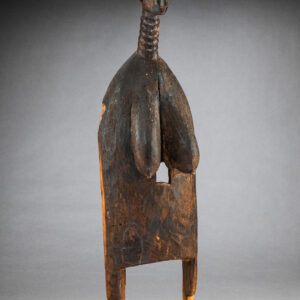
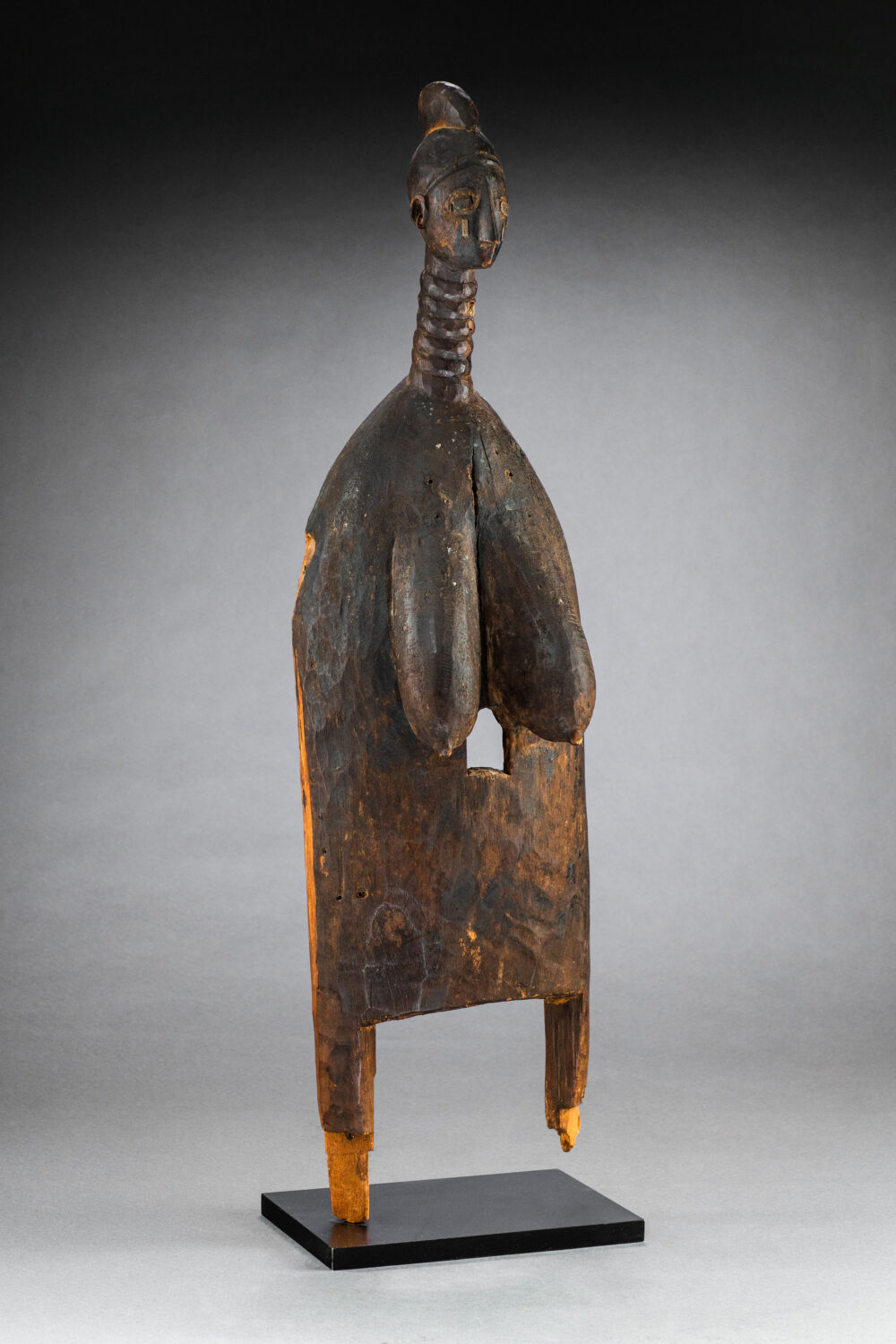
Dance Mask
Baga, Guinea
Wood. nd.
ht: 13 inches
Acc. No. 12.43.13
Gift of Stewart Warkow -
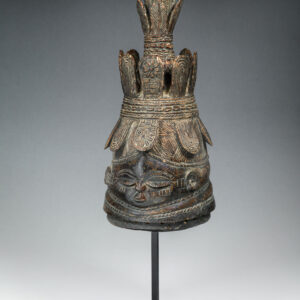
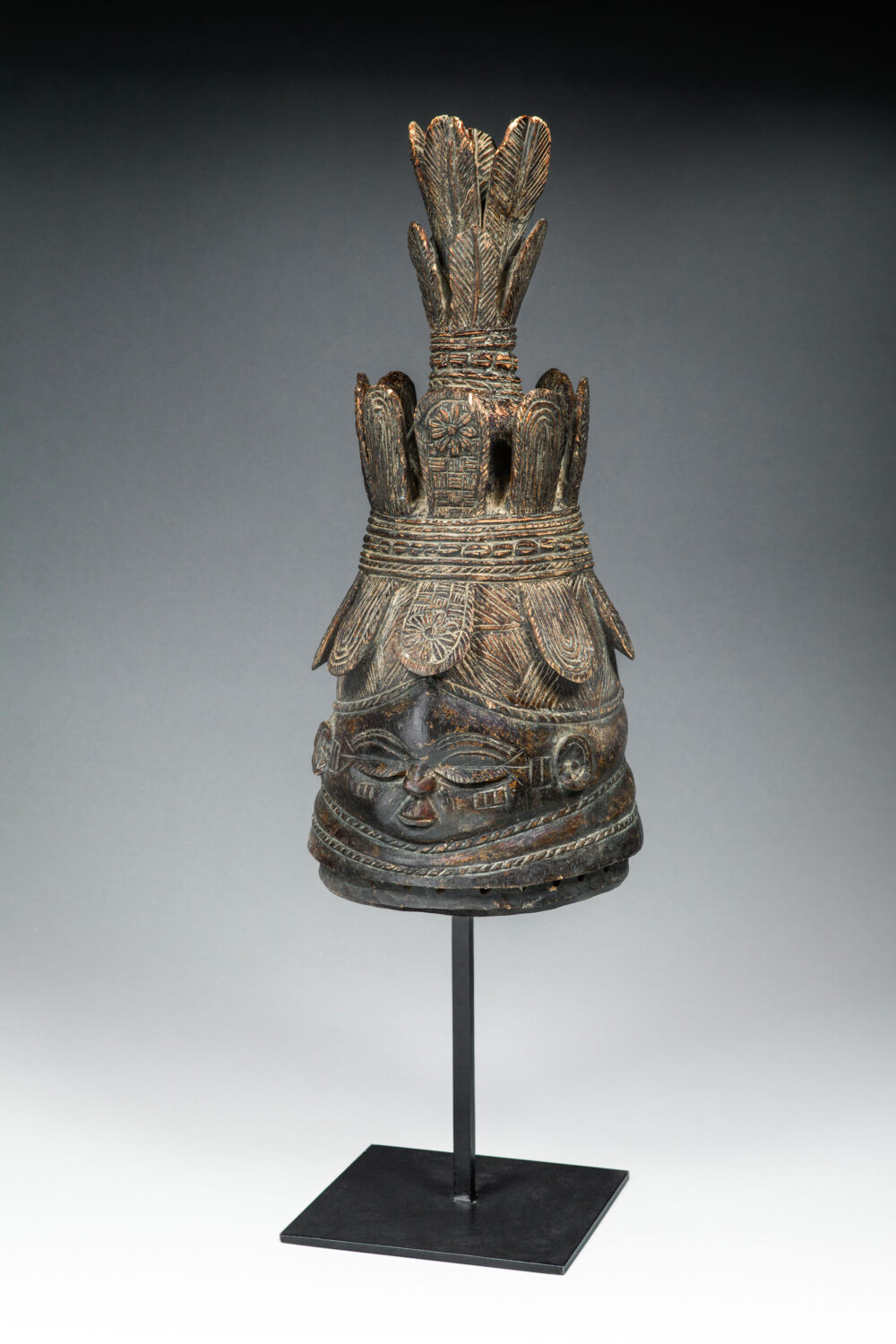
Helmet Mask
Bundu Society, Mende, Sierra Leone
Wood. nd
ht: 21 1/4 inchesIt is a solo example of the Queen of the Bundus. There are rings of attached of cowrie shell in bas relief between the rather compressed neck rings, as well as accentuating the possibly “sprouting leaves
compromising the unique almost feature like surmounting coiffure…if these floral like decorations deed
in represent feathers, then they may be directly related by the feather like headpieces worn by the
Warriors of the Dan complex Warriors.” -

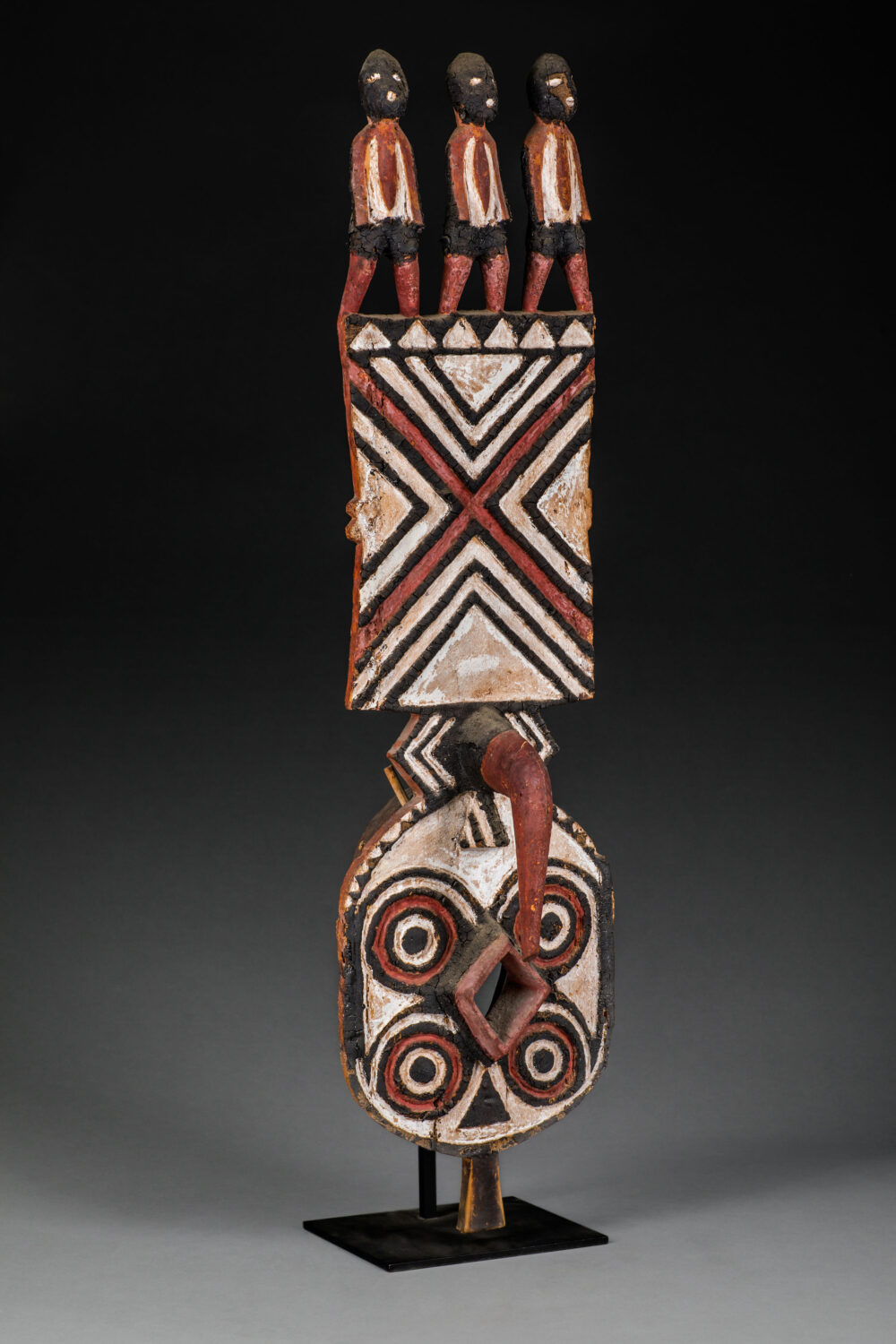
Mask
Bwa/Nunuma, Burkina Faso
Wood, pigments. nd
ht:
Acc. No. 19.06.72
Gift of Eugene Netzer -
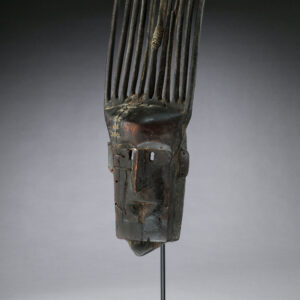
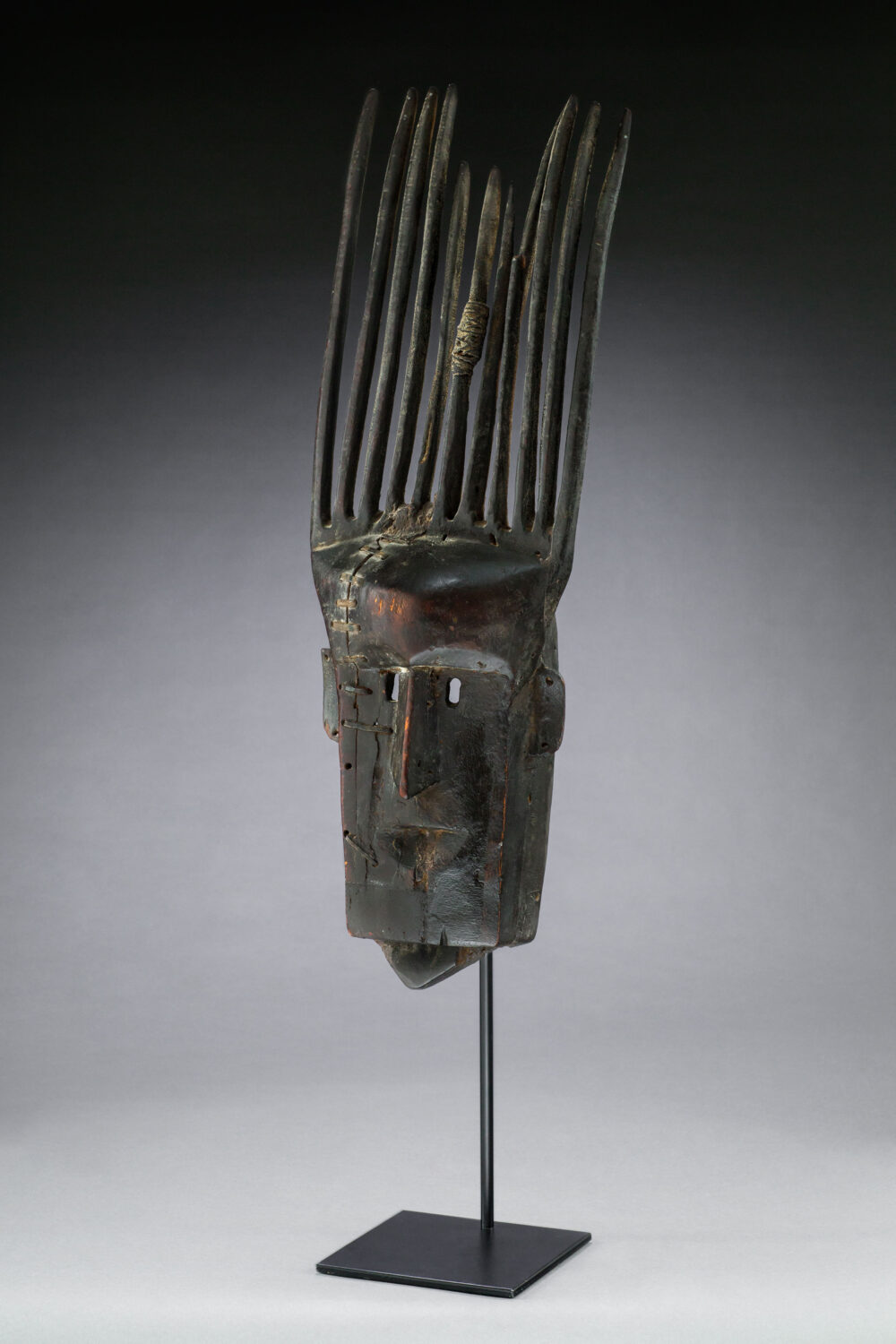
Initiate's Mask
Ntomo Society, Bamana/Malinke, Mali
Wood, metal, cloth, pigment. nd
ht: 21 inches
Acc. No. 09.10.18
Gift of Judith BlumThe mask is from the Ntomo society for initiate’s learning. It has many thin, delicate horns, the middle one reattached. It has an unusual rectangular format for the face, is deep and has triangular formation at
the bottom. -
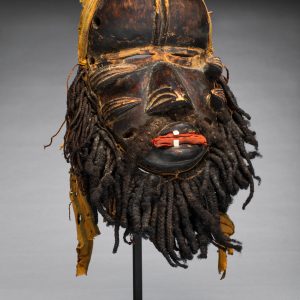
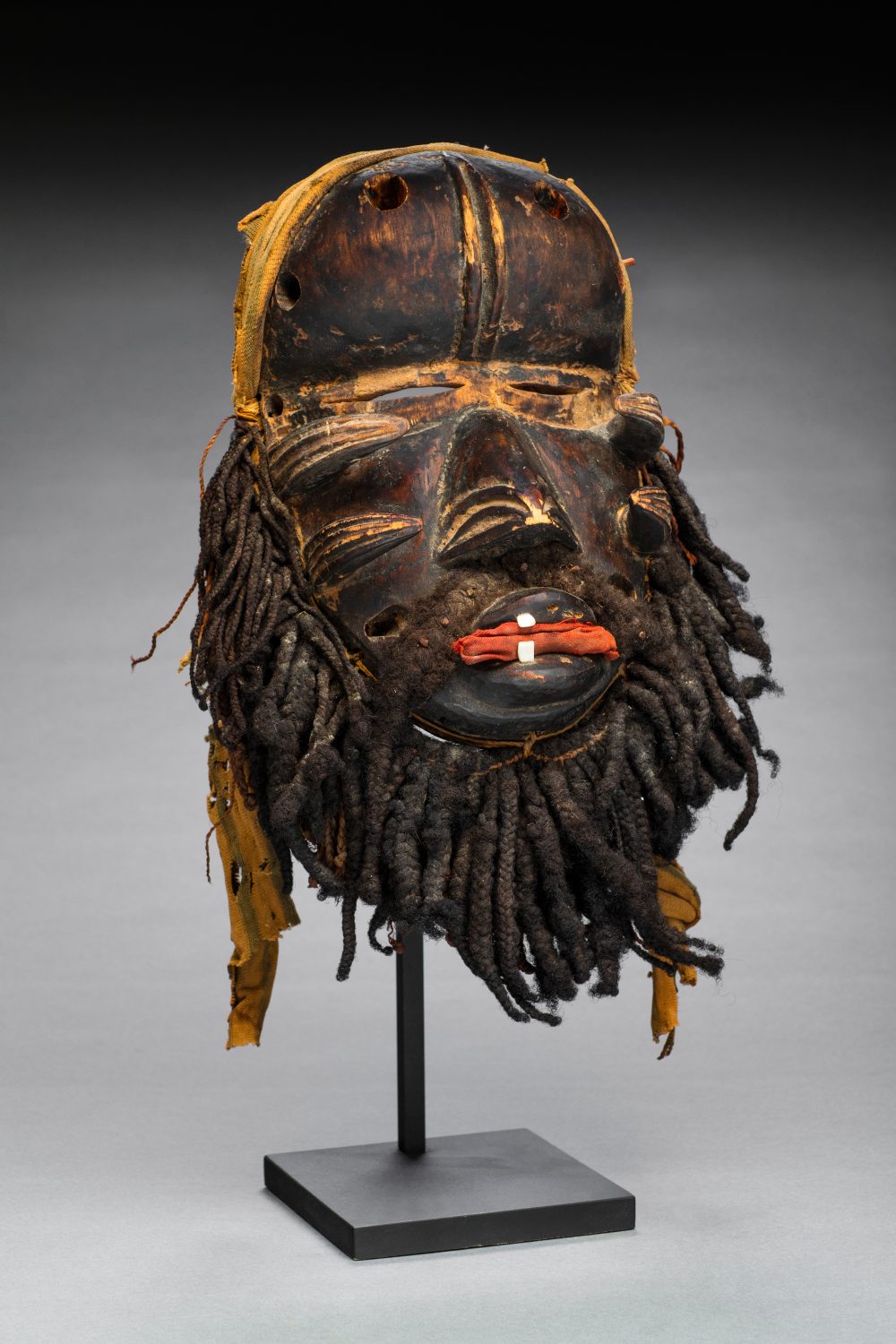
Mask
Dan, Ivory Coast
Wood, textile, teeth, horns, hair. nd.
ht: 18 inches
Acc. No. 03.17.60 -
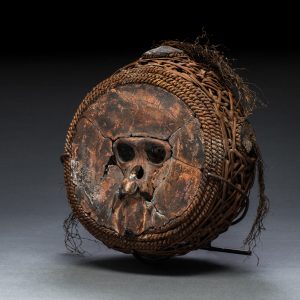
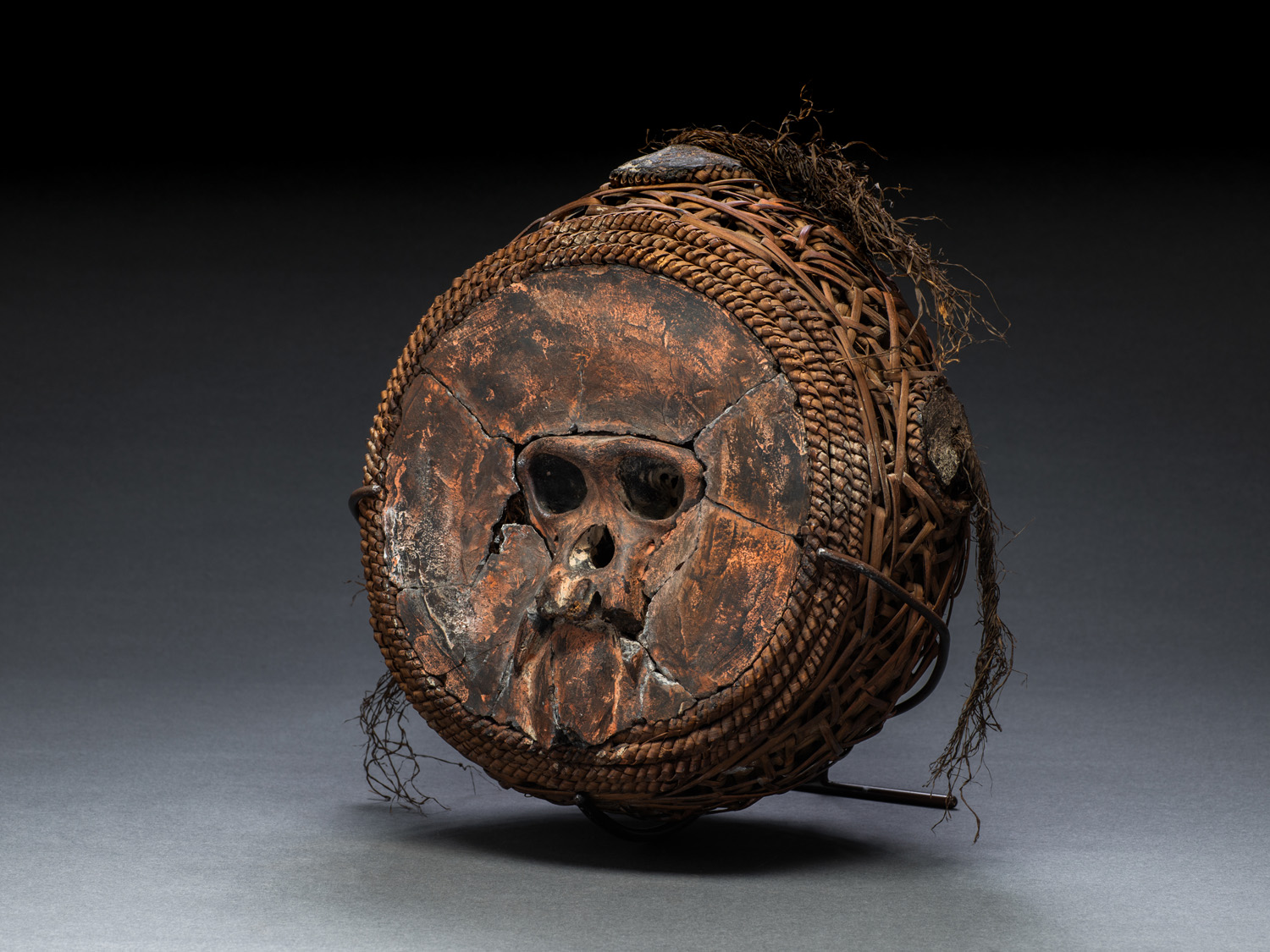
Power Object
Vili, Democratic Republic of the Congo
Wood, skull, wicker, pigment. nd.
ht: 12 inches
Acc. No. 07.03.01
Gift of Jamie Andrade -
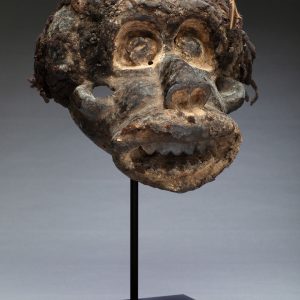
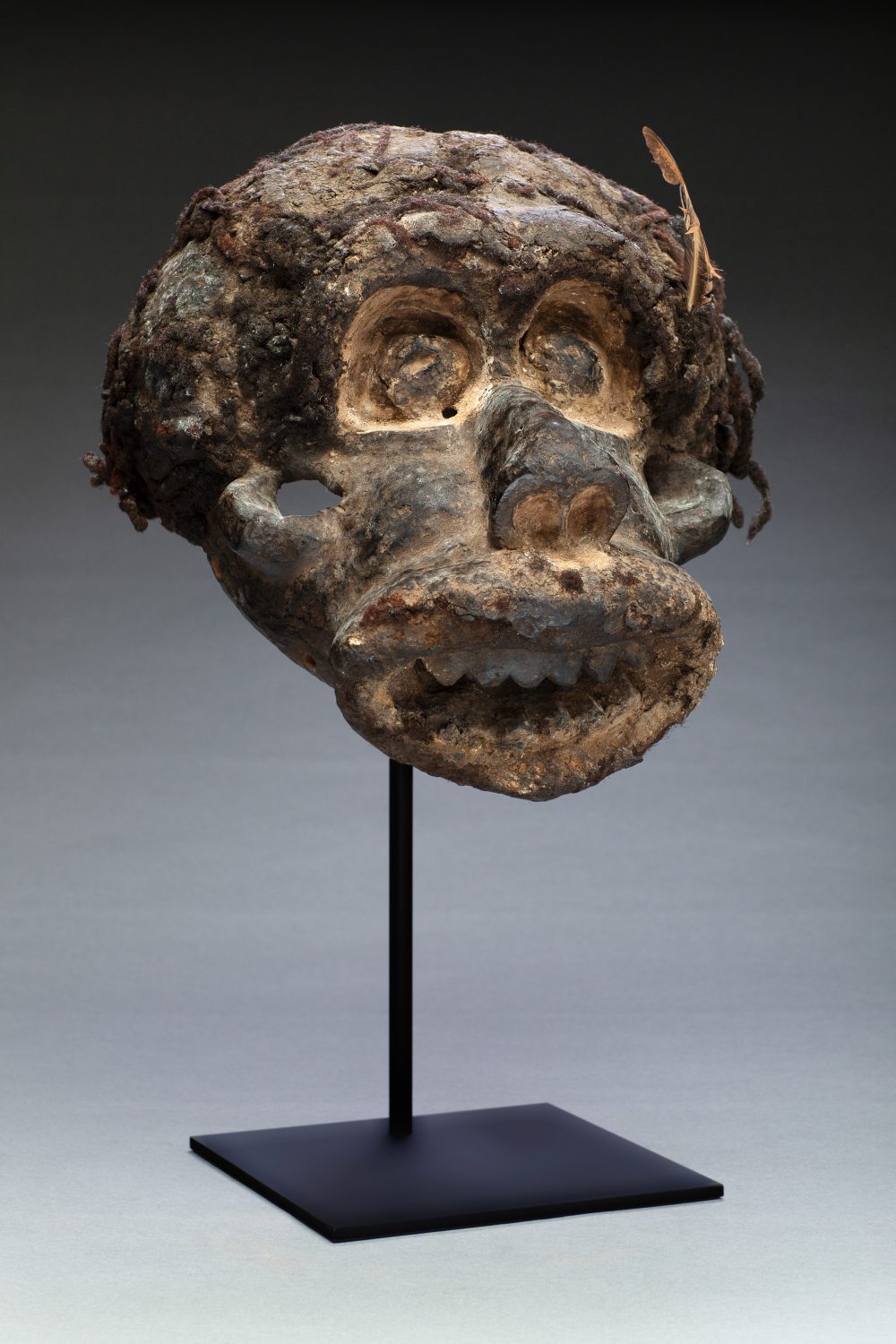
Male Leader Mask
Northwester Grassfields: Oku, Cameroon
Wood, human hair, pigments, feather, sap. mid-18th century.Acc. No. 13.32.01
Gift of Amadou NjoyaMasks such as this are used to commemorate deceased Fons and celebrate the enthronement of the successor. The mask has deep eyes with kaolin pigment; the coiffure
is composed of human hair applied with sap (leh) from Grassfields trees. The sap is believed to act as protection against bad spirits. The feather is a symbol of the title holder (leader). It possibly represents the face of the ancestral
founder of the kingdom. -

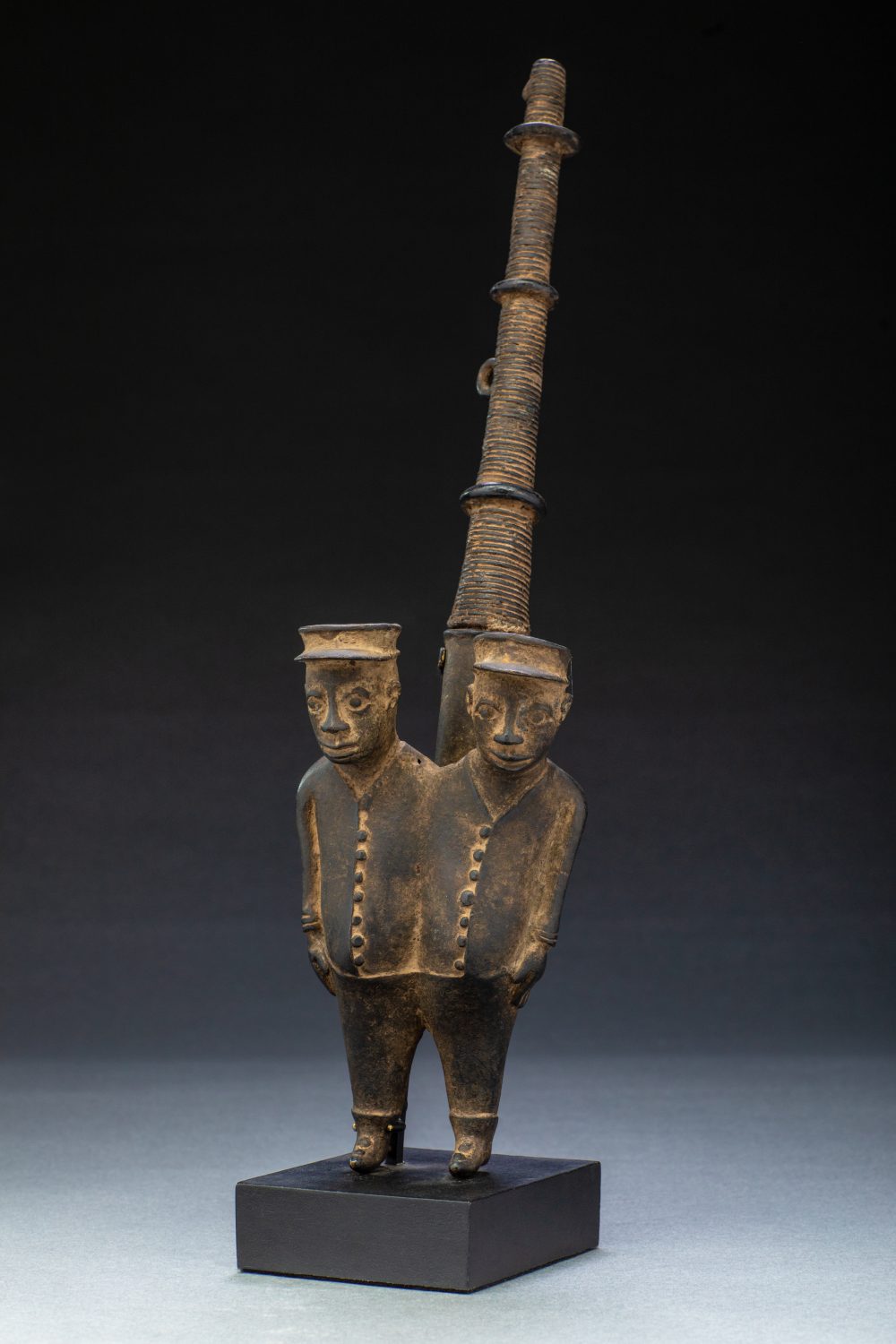
Pipe
Bamoun, Cameroon
Brass. nd.
ht: 16 inchesAcc. No. 01.16.05
Gift of Gary SchulzeIt has two German soldiers standing side by side in their full uniform (jackets with buttons, pants and flat hat with visor.) As they are together they are depicted with one leg each and one arms each, the inside limbs not visually necessary. The long metal stem is elaborate with rings going up to the top and it is the original one, judging by the color of the patina and the type of metal and technique of casting and wax work.
It is most unusual to find a pipe with two soldiers and so large. It should be
noted that the faces are wonderfully rendered as well as the jackets. Kept by Cameroonians for prestige. -
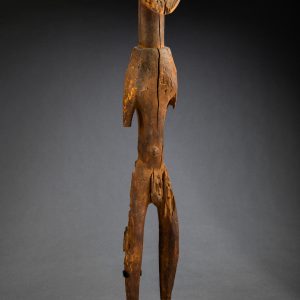
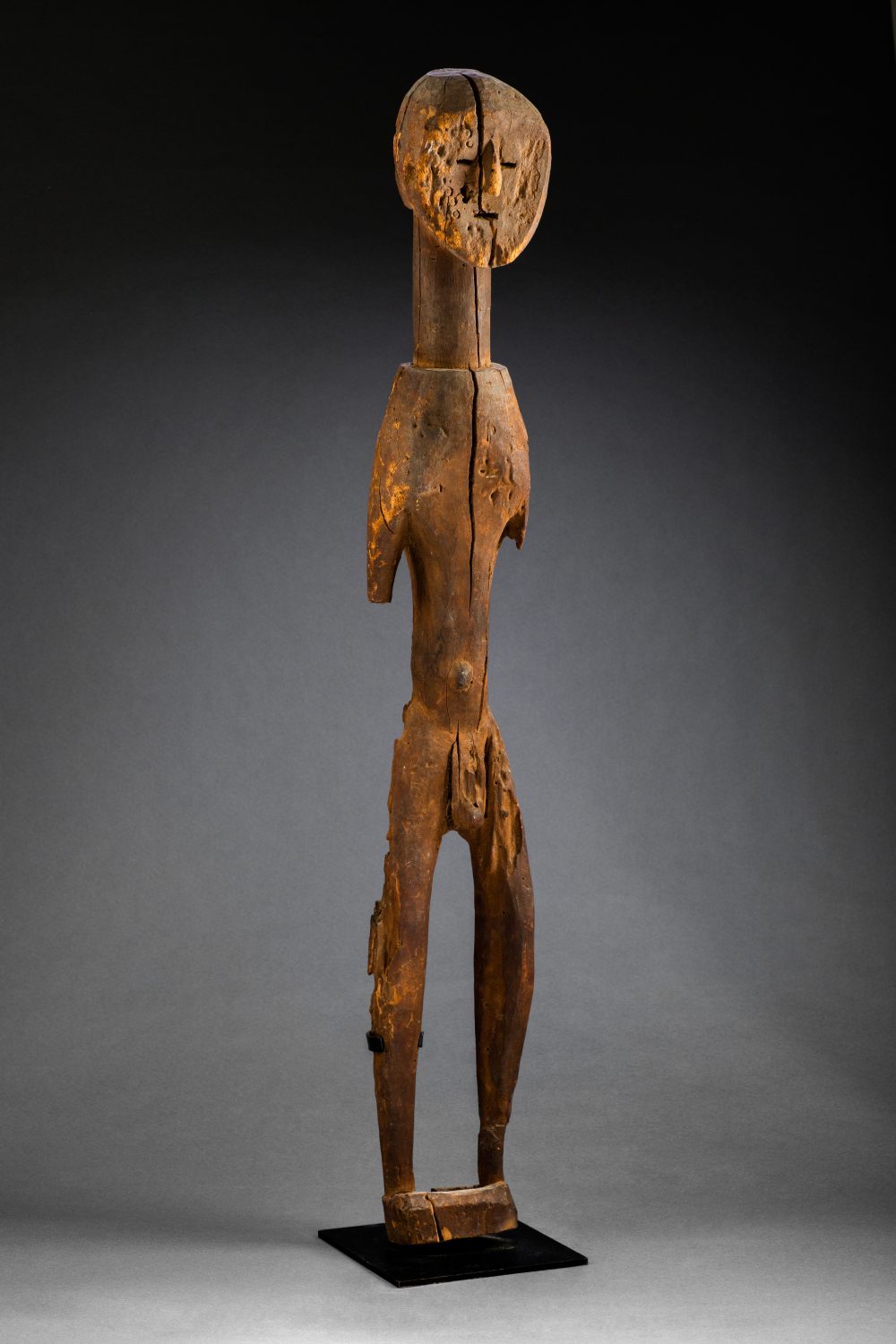
Figure
Tiv, Nigeria
Wood. nd.
ht: 47 inchesAcc. No. 02.20.01
Gift of Brad Jacobson & Eric Jacobson
